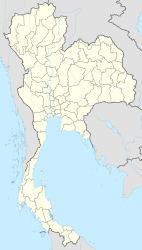Ranong
|
ระนอง Ranong |
||
|---|---|---|
|
|
||
| Coordinates | 9 ° 58 ' N , 98 ° 38' E | |
| Basic data | ||
| Country | Thailand | |
| Ranong | ||
| ISO 3166-2 | TH-85 | |
| Residents | 14,898 (2012) | |
Ranong ( Thai : ระนอง , pronunciation: [ráʔnɔːŋ] ) is the capital of Ranong Province in the southern region of Thailand . It is located in the district ( Amphoe ) Mueang Ranong and has had the administrative status of a "city municipality" ( เทศบาล เมือง ระนอง ) since 1936 .
The city of Ranong has 14,898 inhabitants. (Last updated 2012)
location
Ranong is the northernmost of the provincial capitals of Thailand on the Indian Ocean . It is traversed by the Mae Nam Ranong and is located opposite Victoria Point , which also forms the southernmost point of the mainland of Myanmar . Ranong is one of the rainiest cities in Thailand and is surrounded by a wild mountain landscape and rainforest . Ranong is located about 560 kilometers south of the capital Bangkok .
The large estuary of the Mae Nam Kraburi in the northern part of Mueang Ranong County is protected as a wetland according to the Ramsar Convention . The eastern bank of the estuary north of the provincial capital is part of the Lam-Nam-Kraburi National Park (Thai: อุทยานแห่งชาติ ลำน้ำ กระบุรี ).
Economy and Importance
For a long time fishing and tin mines contributed to the city's wealth. Since the drop in prices on the world market, the plantation economy has been strengthened, which brings rich yields of coffee , kayu ( cashew nuts ) and fruit .
history
Ranong was founded in the mid-18th century by Chinese immigrants looking for work in the nearby tin mines. The Portuguese were the first Europeans to come here and later to receive permission to establish a trading post.
Attractions
- Raksawarin Park ( บ่อน้ำร้อน และ สวน สาธารณะ รัก ษะ วาริ น ) - a sulfur-containing thermal spring with a temperature of around 70 ° C rises here , the park is located on the site of a Buddhist temple (Wat Tapotharam - วัด ตะ โป ธารา ม ). The park has been a tourist attraction since 1890 when King Chulalongkorn (Rama V) visited the hot spring.
- Cityscape - the influence of the Chinese and Portuguese is evident in the cityscape, for example through two-story houses and their arcades
Personalities
- Pratum Chuthong (born 1983), soccer player
Individual evidence
- ↑ Department of Provincial Administration : As of 2012 (in Thai)
- ↑ Information on the Lam Nam Kraburi National Park from dnp.go.th ( memento of the original from September 29, 2007 in the Internet Archive ) Info: The archive link was automatically inserted and not yet checked. Please check the original and archive link according to the instructions and then remove this notice. (in English)
Web links
- City map of Ranong (names in English and Thai) [last accessed on November 17, 2013]
